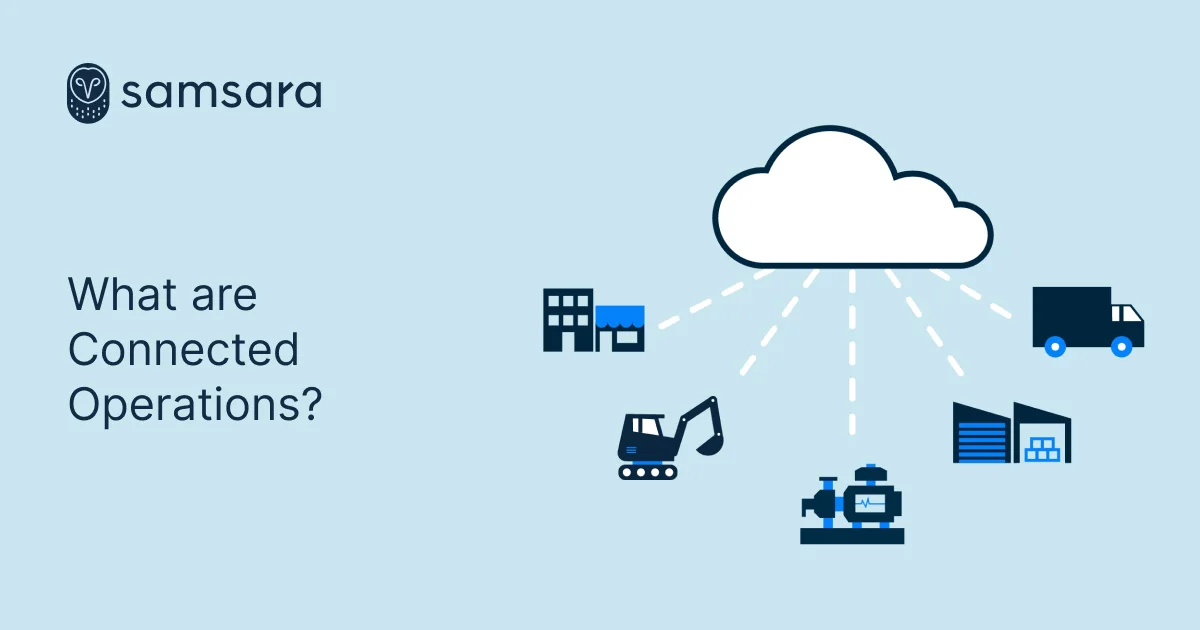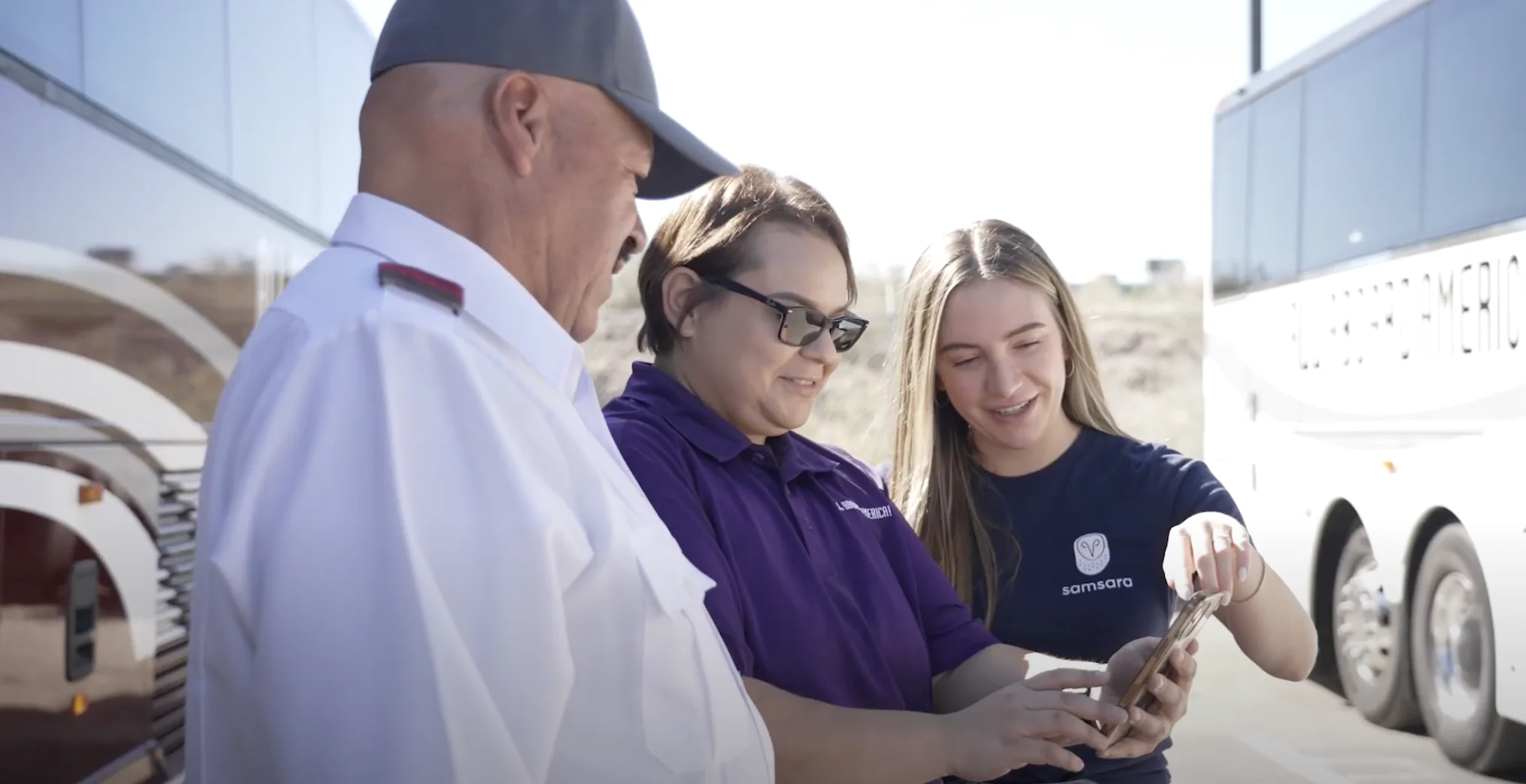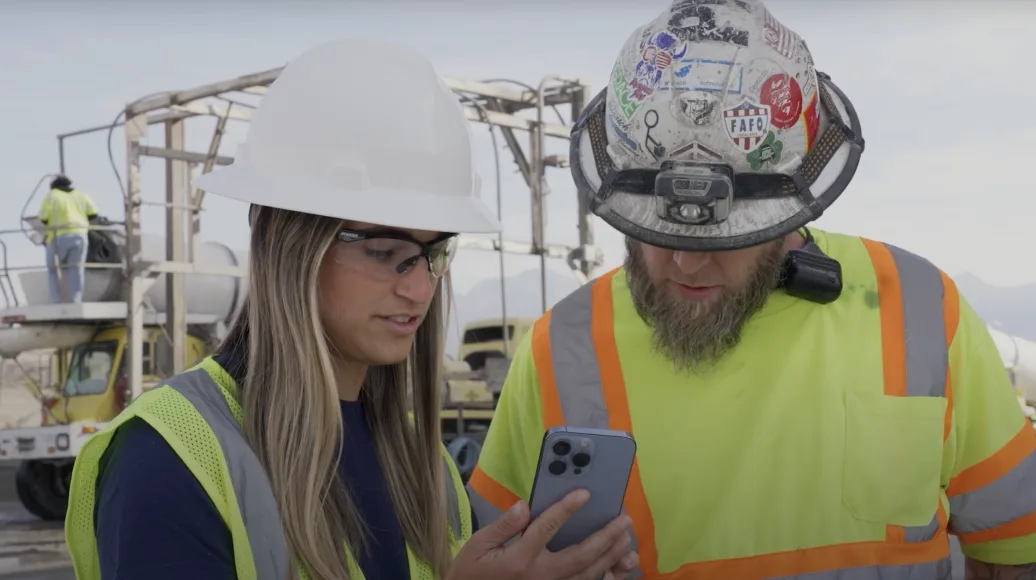What are Connected Operations?
December 16, 2022

Get Started with Samsara
Check Our PricesKey Takeaways
As IIoT technology has become more advanced and accessible, the organizations that keep our economy running behind the scenes have entered an era of digital transformation. In this guide, learn how organizations that manage physical operations are becoming Connected Operations™, and why today’s leaders—from Fortune 500 companies to local governments—see Connected Operations as the future.
Today, we live in a deeply connected world. You can place an order online and have it delivered to your door within a few days. You can check the status of your local bus on your smartphone. You can go to the grocery store and buy a product that was manufactured thousands of miles away. But what makes this possible? The road you walk on, the house you live in, the packages delivered to your door, the groceries in your supermarket—all of this is made possible by thousands of organizations and millions of people working behind the scenes to keep our world running.
This is what we call physical operations, the operations powering our economy through the flow of goods and services—think transporting goods and services, building infrastructure, keeping utilities running, and more. Organizations in physical operations exist across many industries, including construction, transportation and logistics, home and commercial services, food and beverage, local government, passenger transit, utilities, and more.
Organizations that manage physical operations transport goods from one place to another, build the infrastructure we rely on, keep our essential utilities up and running, and beyond. What unites these vastly different organizations under the umbrella of “physical operations” is the nature of their work; they all rely on the safe, efficient, and sustainable operation of physical assets—such as warehouses, vehicles, and equipment—to function.
Organizations that manage physical operations form the backbone of our global economy, representing over 40% of global gross domestic product (GDP). Yet despite their immense impact, these organizations and the people they employ—drivers, field technicians, safety managers, warehouse supervisors—have historically been underserved by technology. While technology revolutionized how most people work and live, behind the scenes, physical operations continued to rely on paper documents and manual processes for many years. Now, that is changing.
As advances in technology make it possible to capture more data from more assets and connect it to the cloud, we are seeing physical operations digitize and transform into Connected Operations: organizations that manage physical operations by using digital technology to connect their assets to the Samsara cloud. This provides organizations with real-time visibility, so they can operate more safely, efficiently, and sustainably.
But what does a Connected Operation look like in practice? And what can we learn from leaders in this space? In this guide, we’ll break down everything you need to know about Connected Operations and why today’s leaders are increasingly embracing this concept.
What does Samsara Connected Operations™ mean?
“Connected Operations” sounds like an abstract concept—something you might read about in a textbook or research paper. But this shift is already having a huge, real-world impact on thousands of organizations around the globe.
The best way to understand what “Connected Operations” means is by breaking down how it has transformed physical operations.
Organizations in physical operations often manage large fleets of assets and employ hundreds or thousands of workers. Some operate warehouses the size of football fields; others manage a great deal of equipment, such as generators, cranes, tractors, and snow plows.
The rise of industrial internet of things (IIoT) technology—which makes it possible to capture data from physical assets and connect it to the cloud—has fundamentally changed how organizations operate. With devices such as computer chips, processors, and sensors becoming plentiful and affordable, “things” that we engage with everyday (such as cars, air conditioning units, light bulbs, refrigerators, and more) can now be connected to the internet, sharing data seamlessly between device and cloud. Cameras, GPS devices, and asset tracking devices have also benefited from IIoT.
For many years, before the widespread adoption of IIoT, organizations in physical operations relied on paper documents, manual processes, and siloed systems. This caused massive challenges, such as:
Lack of real-time data: Before IIoT, the location and status of physical assets was often tracked manually via spreadsheets, phone calls, and written records. Though rudimentary cameras could capture footage in vehicles and warehouses, they required manually retrieving the SD card and reviewing hours of footage to find what was needed. For many organizations in physical operations, this lack of real-time data meant they were often in the dark about the day-to-day of their operations, hindering decision-making.
Limited visibility: In addition, the lack of real-time data meant organizations in physical operations often had limited visibility into the safety, security, and efficiency of their operations. Not only did this put employees at risk, it left organizations vulnerable to inefficiencies such as underutilized vehicles and equipment, wasted fuel, false insurance claims, and the theft and loss of expensive assets.
Manual workflows: Before this recent era of digitization, many organizations in physical operations relied on manual, paper-based tasks and workflows. For example, many organizations used paper documents for driver vehicle inspection reports (DVIRs), which then had to be physically transported back to an office for processing. Not only were these manual workflows inefficient and time-consuming—they were also prone to human error.
Disparate systems: Before the rise of IIoT and Connected Operations, technologies were often siloed, making it difficult for systems to interface with each other. For example, an organization may have had completely disconnected systems for logging drivers’ hours and payroll. This legacy technology was often a blocker to innovation and efficiency.
Digital transformation—the process of organizations adopting modern digital technologies to completely elevate their workflows—has solved many of the challenges physical operations faced before. It has also enabled physical operations to digitally transform into Connected Operations.
Connected Operations use the power of digitization to connect physical asset data to the cloud. Now, organizations in physical operations can consolidate data from IIoT devices into a single system of record by linking up to the cloud, wrangling data across various systems to make smarter decisions. Using the cloud as a command center, organizations can connect data and workflows together to get a full picture of their entire operations.
Here are a few examples of what a Connected Operation can look like across different industries:
A food and beverage company can use advanced telematics to track the real-time GPS location of a temperature-sensitive delivery from warehouse to customer. While on the road, an AI camera proactively alerts the driver to potential safety risks such as tailgating, and a temperature monitor ensures the refrigerated trailer stays within the correct temperature range. Once the driver arrives at the delivery site, they can use a mobile device to digitally capture proof of delivery, which is nearly instantly transmitted to the cloud, triggering an automated billing workflow.
A city government can use AI cameras to capture footage of events happening on-the-road for services such as waste collection, snow operations, and public transit. If a citizen calls to complain about property damage caused by a city vehicle, an administrator can instantly (and remotely) retrieve footage to resolve the complaint. Simultaneously, real-time GPS data is fed seamlessly into a publicly-accessible website via an API integration, providing real-time information on essential city services for both administrators and citizens.
A construction company can monitor their assets—many of which are costly and subject to theft—in real time. Administrators have full visibility into the location, status, and utilization of connected equipment (such as trucks, cranes, and excavators) even if they are operating in remote work sites. If a piece of equipment is stolen, they can track it down quickly and precisely with real-time GPS. All equipment data is centralized in the cloud, providing real-time insights into equipment utilization, diagnostics, and fuel usage, all of which helps the company make smarter business decisions and improve their profit margins.
A home and commercial services company (such as plumbing, electrical, HVAC, and more) can use remote vehicle diagnostics and digital documents to improve service delivery. Unplanned downtime can be avoided by proactively spotting maintenance issues, ensuring that technicians stay on the road with working vehicles. Real-time GPS can provide customers with visibility into accurate ETAs, and when technicians arrive on site, they can streamline their workflows by digitizing important documents such as proof of service, billing, and vehicle inspection reports. All documents are then automatically uploaded to the cloud, where the back office can centralize and automate reporting.
Today, we are only seeing the beginning of what’s possible with Connected Operations, as IIoT continues to evolve. Some benefits of a Connected Operation include:
Real-time data: IIoT technology has made it possible to stream data from physical assets to the cloud. This real-time data enables Connected Operations to make smarter decisions based on in-the-moment insights—covering everything from risky driver behaviors to GPS location, temperature range, maintenance issues, fuel usage, and more. Connected Operations use real-time data to increase efficiency, improve safety, reduce downtime, operate more sustainably, and improve the customer experience.
Complete visibility: Access to real-time data means that organizations can get a full picture of safety, security, sustainability, and efficiency across their physical operations. With visibility into their entire value chain, Connected Operations can more effectively improve safety and security across their distributed operations, coach and engage employees at scale, proactively identify leading indicators, and more.
Connected systems and automated workflows: By connecting real-time data from physical assets to other business-critical systems (such as payroll, billing, fuel management solutions, or third-party equipment software) via API, organizations can automate digital workflows and unify data across multiple sources to a single system of record. System integrations and automated workflows are hallmarks of a mature Connected Operation—an organization that is tapping into the advanced possibilities of cloud-based data.
How are Connected Operations Leaders using AI to improve safety and maximize efficiency?
In 2024, Samsara and Lawless Research surveyed more than 1,500 physical operations leaders across seven countries and 21 industries to uncover insights into how the organizations that drive more than 40% of the global GDP are using artificial intelligence (AI) to enhance safety, maximize efficiency, and empower their employees. Our recent State of Connected Operations Report—Smarter, Faster, Safer: The AI Revolution in Physical Operations—reveals leaders in physical operations are leveraging AI as a competitive advantage to realize positive ROI across safety and productivity.
More than half (51%) of leaders surveyed are already using AI, and an additional 42% are planning to use it or open to using it within the next 2 years.
94% of leaders surveyed believe their organization needs to invest in AI to keep up, and 87% expect to increase their AI investments in the next year.
Of those already using AI, 90% say their employees feel positive about it—a sentiment that applies across industries and regions.
58% of those already using or planning to use AI in the next 1-2 years are implementing privacy and data protection measures.
To learn more, download the full report to access additional findings and takeaways for future-proofing your operations with AI.
What is driving the rise of Connected Operations?
There are many factors that have contributed to (and accelerated) the rise of Connected Operations. Below are a few of the most impactful factors:
Technological innovation: Over the past decade, IIoT technology has reached a critical inflection point. Cameras and sensors have become more portable and affordable. High-bandwidth cellular networks have made it possible to stream incredible volumes of data in real time. Efficiencies in cloud computing and storage have paved the way for artificial intelligence (AI) and automation. As these technologies have become more accessible, affordable, and advanced, their applications to organizations in physical operations have multiplied; just a few examples include telematics, AI cameras, workflow apps, and asset tracking.
Macroeconomic pressures: The past few years have been marked by unprecedented macroeconomic challenges, including global supply chain disruptions, labor shortages, high fuel costs, and inflation. These market pressures have made operational efficiency more critical than ever. To survive, organizations in physical operations need real-time visibility into every aspect of their operations so they can identify inefficiencies and remain agile in the face of ever-evolving market demands.
Government regulations: Government regulations have also been a significant factor in the digital transformation of physical operations. Regulations requiring the electronic tracking of hours of service (HOS), such as ELD mandates in the United States and Canada, propelled the widespread adoption of telematics. More recently, regulations related to sustainability have pushed organizations in physical operations to fundamentally change how they operate.
Increased focus on sustainability: Transportation is the fastest-growing source of emissions worldwide, accounting for 17% of global greenhouse gas emissions and 20% of global CO2 emissions. Increased regulatory activity, shifting customer and investor expectations, and the growing availability of commercial electric vehicles (EVs) have driven an increased focus on (and investment in) sustainability across organizations in physical operations. As organizations invest more heavily in sustainability, they are increasingly in need of operational technology that can help them understand their carbon footprint, inform ESG initiatives, and plan for fleet electrification.
Workforce attraction and retention: The people that keep our physical operations running—drivers, field technicians, safety managers, warehouse supervisors, and beyond—have historically been overlooked and underserved by technology. Today's operations workforce is demanding easy-to-use technology that helps them do their jobs more efficiently and safely—and helps their employers operate in a more socially and environmentally responsible way. The labor shortage has brought this further into focus by underscoring the need to recruit and retain the next generation of employees.
Customer and investor expectations: Beyond sustainability, customers and investors are pressuring physical operations to digitize their operations for other reasons as well. In today’s world, real-time information has become the norm; customer satisfaction (and even customer loyalty) depends on efficient and accurate communication, and investors expect physical operations to have a modern technology stack to remain competitive.
What will Connected Operations look like in the future?
We are at the beginning of a long-term digital transformation. As physical operations become increasingly digitized and connected—and as new technology enters the digital landscape—the concept of what a “Connected Operation” looks like will continue to expand and evolve.
In the coming years, advances in cloud computing, machine learning, and AI are expected to unlock new use cases for organizations in physical operations, many of which will be tailored to specific industry needs. Innovations will likely make it possible to connect more types of physical assets to the cloud, collect different types of IIoT data, detect a broader array of events in real time, and automate new and unique types of business processes. For example:
As edge computing capabilities continue to advance, AI cameras will be able to detect a broader range of events in real time with greater accuracy—enabling a wider array of real-time safety alerts that help prevent potentially fatal incidents. In fact, 100% of organizations using AI report experiencing benefits, including improved safety (45%) and employee productivity (42%).
API integrations will become even more commonly used to connect previously siloed systems, automating previously manual workflows and nearly eliminating tedious data entry.
With electric vehicles (EVs) replacing diesel vehicles, analytics that offer insights into EV routing, charging, and range will enable the management of mixed-fuel fleets and streamline the journey to electrification.
There is no doubt that the Connected Operations ecosystem is continuing to grow and evolve. Ultimately, the concept of Connected Operations is all about empowering people to work smarter, unlocking the power of data to optimize decision-making.
Learn more about the technology that’s enabling the Connected Operations revolution
Samsara’s mission is to increase the safety, efficiency, and sustainability of the operations that power the global economy. We are the pioneer of the Connected Operations Cloud, which allows organizations in physical operations to harness IoT data to develop actionable business insights and improve their operations.
Samsara serves thousands of customers across a wide range of industries including transportation and logistics, construction, home and commercial services, utilities and energy, food and beverage, healthcare and education, government, and manufacturing.
Learn more about how the Connected Operations Cloud is transforming physical operations across the world.
Learn more
